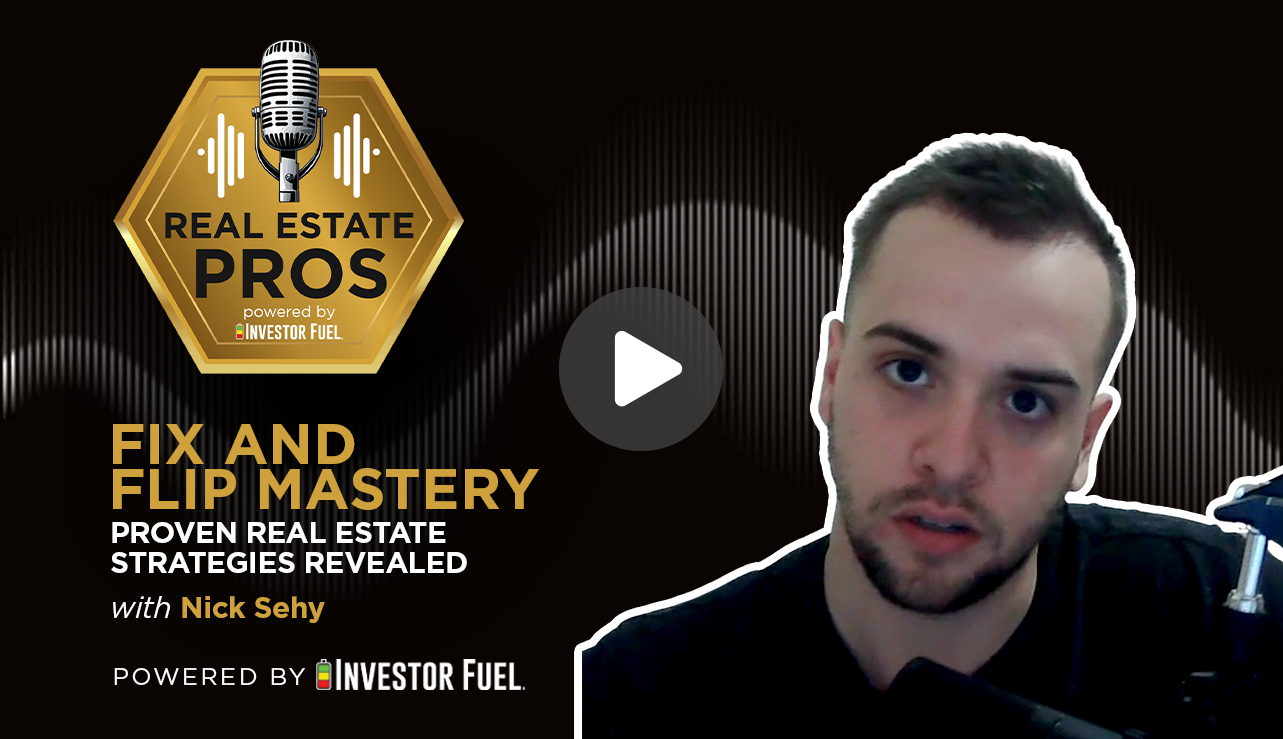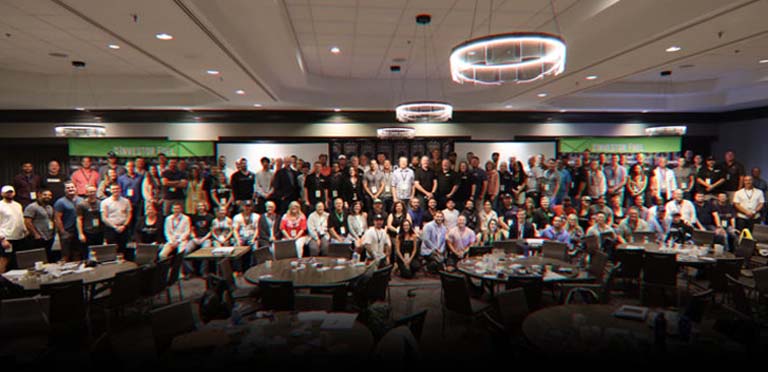
Show Summary
In this conversation, Dylan Silver interviews Nick Sehy, a real estate investor who transitioned from a software engineering career at Microsoft to investing in the Detroit real estate market. Nick shares his journey, including his initial interest in real estate, the strategies he employed such as the BRRRR method, and his pivot to fix and flip properties. He discusses the challenges and lessons learned from his first fix and flip, the reasons for choosing Detroit as his investment market, and offers advice for aspiring real estate investors. The conversation concludes with insights into future trends in real estate investment.
Resources and Links from this show:
Listen to the Audio Version of this Episode
Investor Fuel Show Transcript:
Dylan Silver (00:00.895)
Hey, folks, welcome back to the show. I’m your host, Dylan Silver. And today on the show, I have Nick Sehy, real estate investor, entrepreneur investing in the Detroit market based out of Seattle himself. welcome to the show.
Nick Sehy (00:16.076)
Hey, good to have, good to be on here.
Dylan Silver (00:18.909)
Absolutely. Yeah. Before we hopped on here, I was talking about Seattle and the investors that I’ve spoken with in the Seattle area. But you have an interesting strategy. You’re investing in Detroit based out of Seattle. And I saw on your bio, if I read it correctly, a tech background, software engineering background. So talk to us about how you got into the real estate space.
Nick Sehy (00:30.21)
Yeah.
Nick Sehy (00:40.878)
Yeah, so I mean I was previously a software engineer at Microsoft getting out of college, so I was 22, 23. I think within a couple years I realized this isn’t really something that I want to do. And I think I started like many people just kind of wanting a different path, like something that…
you know, allows you to experience more and not be stuck in a nine to five. Um, so at that point I was doing a lot of burrs. I started in 2020 just doing burrs, um, did that for about three years and then interest rates spiked and now I’m mostly doing more flips. Um, but still do a burr occasionally as well.
But yeah, think my goal eventually was to just do burrs and to catch well enough from burrs. But now I’m doing well with flips, so that’s kind of my method.
Dylan Silver (01:32.991)
So going from the engineering space to a real estate investor, did you have any mentors? it reading? Was it YouTube? How did you make the jump? Was it in your blood? Did you have family that was involved in it?
Nick Sehy (01:47.704)
Yeah, that’s a good question. So my dad actually hates real estate. Every time I bring it up, he’s like, yeah, I would never do what you do. I hate tenants and everything. So yeah, so he, like, my mom has no, just no clue. I mean, she’s a, she’s a pediatrician, but she’s never really owned a rental property in her life. But what I read is I read Scott Trenches is called a set for life. So Scott is the CEO of Bigger Pockets. And from there he talked about kind of house hacking and the
Dylan Silver (01:55.349)
Ha ha.
Nick Sehy (02:17.648)
power of real estate. And from there, it kind of, I was kind of interested in like, you know, like, how can we do real estate without having to put 20 % down? And like, it seems like why wouldn’t I just put in the stock market? But then, but then at that point, I read David Green’s Burr book. And then I was like, oh, wow, this makes more sense if I can just keep using the same capital every like five or six months. And then just like, you know, it just has a snowball effect, essentially. And then
Dylan Silver (02:46.537)
Now, is that, is that burst strategy? I haven’t done it myself. I’ve heard so many people talk about it. And this book by now is like almost, yeah, it’s, it’s, it’s so, it’s, it’s so profound and prolific in its use. So many people have mentioned it. yes, this specific and there may, I’m, I’m sure now there’s many other, but I believe that one was kind of the one that hit it off. Is that, am I on, is that, is that correct?
Nick Sehy (02:55.796)
seven or eight years old, yeah, think it’s been a
Nick Sehy (03:02.83)
Does everybody tell you that one? About that one? Okay.
Nick Sehy (03:14.528)
I think so. I mean, I don’t know if I’ve read another bird book or seen one, to be honest with you. So maybe this is a call for somebody else to create a bird book.
Dylan Silver (03:23.979)
So you read the burr book and at that point it clicks in your head. I can use the same money over and over again on further projects and I don’t have to have this nest egg that keeps accumulating. I don’t have to keep restocking the nest egg. And so from that initial point where you read Set For Life, you read the burr book, how long was it until you got your first deal?
Nick Sehy (03:33.41)
Right.
Nick Sehy (03:50.158)
I’d say about… I’d say 8 to 9 months. Yeah, I’d 8 to 9 months.
Dylan Silver (03:55.303)
Okay, yeah, that’s not that’s not long at all. I mean, I can tell you for me, I was selling cars working for a Nissan dealership in San Antonio, Texas, knew I wanted to do something different. And it was probably about two years before I got my first wholesale deal. And I think a lot of people have this analysis paralysis as as I did at that point in time. And so to hear someone going from I’m going to think about it, I’m reading two books that now I have my deal in under a year. That’s
Nick Sehy (04:07.022)
wow, okay.
Nick Sehy (04:23.758)
Mm-hmm.
Dylan Silver (04:24.945)
fast growth although it might not have felt like it at the time. So you get your first deal Nick. It was a burr that you did for the next one.
Nick Sehy (04:31.182)
Yep, it was a burr. was a burr. So, you know, back, was back in 2020. And then, I think it was January, 2020. And then March, 2020 is when COVID hit. And then like we had to stop construction for a month. I’m like, oh, you know, real estate is great. So, and then, but yeah, no, it actually turned out a great deal. We bought it for, or I bought it for 47.
Dylan Silver (04:49.077)
Wow.
Nick Sehy (04:57.39)
55 into it then refight around 160 so it was a perfect burr actually at my first one but that’s
Dylan Silver (05:04.508)
So that’s a pretty, it was fortuitous and it was also well executed, right? So from that one, you go to your next deal and was it just as lucrative on the second one?
Nick Sehy (05:17.55)
The second one I don’t I I think I think I got 40k equity on the second one I think if I remember the numbers raise about 60k purchase about 50 60 and then I think it refied around 165 so I think I had a little bit left in but maybe like 5 or 10k
Dylan Silver (05:38.367)
So at that point, working for Microsoft, you have two properties at this point, and are you thinking in the back of your head, I’m gonna keep working for Microsoft until my income from real estate replaces, or are you thinking I’m just gonna do both and see what happens?
Nick Sehy (05:52.75)
I was kind of just thinking to do both and write it out and see at what point does it get to unmanageable territory. I just kept writing it out because we get a nice salary at Microsoft, obviously. So I was just keeping that up.
Nick Sehy (06:15.958)
Either I get enough cash flow where it just covers my Microsoft salary or it just becomes too much work is what my plan was.
Dylan Silver (06:24.041)
So getting the second property under contract, then I’m imagining you’re looking at other properties as well, and you’re using the burst strategy. At what point did fix and flip come into play?
Nick Sehy (06:34.574)
Uh, 2023, like when I don’t, maybe you’ve talked to other people, but like whenever the interest rate shut up, like, um, there was a point like when the interest rates were like two or three, like I didn’t even have to do, like, I didn’t even have to do a rental analysis, like to see like, okay, like this thing’s getting cashflow cause like, you know, like it was, you know, it was just like almost anything you touch is like three or $400 a profit no matter what. then
interest rates go up to like 7-8 % and then you have to question like do I really want to do all this work for break even slash lose money every month.
Dylan Silver (07:09.737)
Yeah, I mean, I’ve spoken with a number of investors about this specifically. People have different perspectives. I’ve spoken with some who draw hard line. If I’m not profiting off of the rents, I’m not going to do it. Other people will say, well, if I know it’s going to appreciate in the market, I might take some kind of a loss. But you’re seeing at this point, you’re seeing that happen. And rather than kind of throw your hands up and say, well, what am I going to do? You say, I’m going to pivot to fix and flipping, which, by the way, is really a hallmark of a
effective real estate operator. call it real estate or entrepreneurial neuroplasticity. You have to be able to adapt. And it’s hard. It’s hard to go from talking about burst strategy to fix and flip or from fix and flip to note buying, hard money lending, which I’ve seen a lot of people do. So you pivot at this point. So you’re still managing, I’m assuming you’re still managing those properties. You have them.
Nick Sehy (07:45.518)
You
Nick Sehy (07:54.988)
Right.
Nick Sehy (08:03.502)
Yeah, so I still have 13 units in Detroit.
Dylan Silver (08:07.689)
and then you move to the fix and flip strategy, which requires a whole other skill set, right? So let’s walk through that first deal.
Nick Sehy (08:14.754)
Yeah, I think the main thing with the fix and flip essentially, before you get to the first deal, just, I think just the materials are different and you have to really more think about the design is the main thing. Cause a lot of these birds, you can put in more of the rental quality stuff cause you know it’s just gonna get beat up after a while. But with the fix and flip, you’re really trying to put in the elite stuff.
if that makes sense. So that’s gonna make a difference.
Dylan Silver (08:44.373)
So you’re doing the fix and flip and I’ve worked on fix and flips as a contractor. I’ve done demo work, I’ve seen people do foundation, plumbing, electrical, and you go into these things, especially if it’s a heavy flip and you’re like, wow, you know, this is kind of remarkable what we’re doing here. So you have this experience for the first time and are you partnering with someone who’s a contractor? How are you managing the work that’s getting done here?
Nick Sehy (09:10.67)
So I’m trying to think of my first fix and flip because I was doing burr forever. can think the first one I can think of is there’s one in a historic district that I had to do. So in Detroit there’s a historic district of houses that were kind of built in the early 1900s where really nice big kind of mansion type houses that are really close to each other.
I remember the one mistake I made is that in these historic districts, before you change any of the exterior, you need to ask the historic district. Even putting a different paint color on there, you have to ask the historic district. So what I did is they had this really ugly porch. And I’m like, OK, if I just match the neighbor’s porch, I won’t have any issues with the historic district.
Dylan Silver (10:06.431)
and they made a huge think out of it.
Nick Sehy (10:07.598)
Yup, so I take out that porch for four grand and then I put up the new, or so I put it, I take it down and put up a porch that matches the neighbor for 4,000. I start to get fined for that. And then you’re like, then I go, I have to go to this historic district meeting and it’s basically just one to 75 year old people that don’t have anything else better to do in their day.
They’re good people, I’m sure. But if you guys are hearing me, guys are, you guys have a, it’s definitely good that you guys do your work, but you know.
But yeah, essentially like they told me to put it back down and I had to go back to what I previously had. So it cost me eight grand to basically tear down the porch and put it back up. So that was the one mistake I made on my first fix and flip.
Dylan Silver (10:55.719)
Now, do you think I’ve gotten the sense from talking with people who do a lot of work with cities and there’s kind of two approaches, there’s kind of a combative and then there’s also a let’s win, let’s create a win-win here. So like historic districts, a lot of times these can be distressed, dilapidated properties for lack of a better term and someone needs to come in and develop it, right, or modernize it in some way just to make it more livable, right, or livable. And so…
Nick Sehy (11:06.574)
Mm-hmm.
Nick Sehy (11:11.95)
Mm-hmm.
Nick Sehy (11:21.453)
Yeah.
Dylan Silver (11:22.353)
If do you do you think hindsight being 20 20 if you had gone in and said hey this neighbor has this porch I’m more or less gonna do the exact same thing. Can I do it? They would have been like yeah go ahead or it was just no no matter what
Nick Sehy (11:34.19)
No, it was no matter what like they were totally for the preservation like I brought that up in the argument I’m like hey like I even brought a picture of the neighbors one brought, you know brought up the matching porch that I did and they’re like, nope You have to put up the old one. It’s like all right So basically like what they told me is like before I make any exterior changes just they gave me the email and just basically asked them before and I have to like do a pre-approved design I have to do a design too and go to that meeting
Dylan Silver (11:44.971)
You
Nick Sehy (12:03.35)
So it’s kind of painful, definitely.
Dylan Silver (12:04.735)
Yeah, I would imagine after that that it changed your buy box as far as maybe steering clear from historic or did you continue buying in those areas?
Nick Sehy (12:11.626)
nope nope just cuz you know that’s where i see the highest margins in detroit so that’s where i buy just you have to know the rules essentially like that’s kind of what i’m playing the rules like really aren’t that hard like i i could have worked with that that original porch like try to figure out something but
Dylan Silver (12:17.961)
Okay.
Nick Sehy (12:32.462)
I don’t know if it was stupid or I just like I was kind of like you know I was like you know I should have just my homework I think is the main point I’m trying to say
Dylan Silver (12:43.135)
So from fix and flipping, you’re continuing that fix and flip strategy for multiple flips in the historic district. You have your BRRRR portfolio that you have. At this point, are you still with Microsoft or have you now replaced your income and are doing this full time?
Nick Sehy (12:59.884)
Moving to full time now, so I’m actually getting my MBA at University of Washington, but then in June I’m planning on moving out to Detroit and just doing it full time. Yeah, I have six or seven projects going on right now, so it’s really good for me to be there and just really be scheduling contractors and shorting up the timelines as well.
Dylan Silver (13:22.271)
How did you pick Detroit, by the way, of all the cities you could have picked, right? Detroit, of course, may not be the one that a lot of people think of as hotbed of real estate, but of course it is ripe for that type of innovation. Where was the impetus to pick Detroit?
Nick Sehy (13:25.731)
Yeah.
Nick Sehy (13:37.566)
So number one, I grew up there. So I grew up in Birmingham as a suburb Detroit. Number two, I go back there every year and I see the slow progress of the city. Like basically when I left in 2008 from when now, it’s really changed. It’s had really good leadership and really good investment from people like the owner of the Cleveland Cavaliers. He’s basically bought up almost the entire downtown and transformed it.
Dylan Silver (14:04.058)
well.
Nick Sehy (14:06.67)
The population of Detroit last year finally went up for the first time in 60 years. So I’ve kind of just been seeing this slow arc towards moving back. And there’s just been a lot of investment there too. So that was another thing. And originally when I started, I picked San Antonio.
literally went to San Antonio and tried to find deals but I found it was very competitive especially as a new investor. A very competitive place and like I’m like dang like I’m trying to get like 70 be all in around 70 % ARV and like man everything is just super competitive. And then I moved to Detroit and I’m like god like I can find this stuff like just walking in the street. It’s not that hard like
Dylan Silver (14:36.607)
Yeah, it is.
Dylan Silver (14:56.139)
Hahaha
Nick Sehy (14:59.886)
And so it’s just bigger candy there. I think San Antonio obviously seems like a great market still. But for me, it’s a lot easier to find deals as well.
Dylan Silver (15:11.359)
Yeah, no San Antonio. I lived in San Antonio for five years, the better part of five years. And I actually moved from San Antonio to DFW because I found DFW is still of course very competitive and in many ways more competitive than San Antonio. But what I found specifically in San Antonio is that for entry level investors, specifically what I was doing with wholesale, there just didn’t seem to be as many.
pieces of the puzzle that I could put together myself as someone in the entry space. There wasn’t end buyers that were coming to me. There wasn’t all these different mentoring opportunities, which there are there. Don’t get me wrong. There’s lots of people down there in San Antonio. But when I moved up here to DFW, it was just a huge paradigm shift. was like, this felt like the real estate hotbed of all things Texas. And so you may have experienced some level of that, although we were on different sides. was wholesale, you were in…
Nick Sehy (15:55.863)
Yeah.
Dylan Silver (16:01.983)
you were burned fix and flip. But pivoting a bit here, Nick, so for folks who are in the W2, you you have a software engineer background going to get your MBA. A lot of people think it’s a zero sum game. You have to either pick the real estate or you have to pick your career because it’s a lot of extra time that goes into running a fix and flip or to managing tenants and so on and so forth.
And of course, your perspective is going to be based on the software engineering space. What would be your advice to folks who are in that space and trying to think, well, I don’t have anybody in my family who’s in real estate. don’t really know about we’re talking about burr, fix and flip, long term hold, corporate housing, short term Airbnb. Where do I start? And so what would be your advice to those folks?
Nick Sehy (16:51.566)
I mean, think it just for you, have to figure out what you want. If you want more of a turnkey stuff and you want to just keep growing the W2, then maybe that’s right for you, less work. For me, I just didn’t really see myself going up the Microsoft chain. It didn’t really fit me what I wanted to do. And I knew that Burr was the fastest way to get out of that, that I personally saw.
There’s definitely a debate, like I could have done Airbnb to get more cash flow or something, like now that I look back at it, but burger was the kind of thing I started with. So that’s just kind of what I saw. it’s hard for me to give a one size fits all for anybody, but I think the nice thing for me about real estate too is I have a lot more control over the asset. For the stock market, like…
Dylan Silver (17:36.971)
Sure.
Nick Sehy (17:50.134)
like what is it, week or two ago, the market’s just like freaked out over Trump’s tariffs. And then like all these people freaking out and like, I don’t know if you’re in real estate too, but it’s just like, we’re just like, okay, like I can’t sell a house in three months, so whatever, you know, whatever happens happens.
Dylan Silver (18:04.989)
Yeah, yeah, I’m a licensed agent in Dallas and so I’m newly licensed and I got my license because as a wholesaler, I don’t know if you’re familiar with this, but there’s a lot of effectively conflict between wholesalers and real estate agents. Real estate agents kind of look at wholesalers like unscrupulous characters and wholesalers look at real estate agents as thinking that they are the only people that are allowed to do any type of anything in the real estate space. And this actually came to a head Nick because I
Nick Sehy (18:20.142)
Mm-hmm.
Nick Sehy (18:30.734)
Yeah, yeah.
Dylan Silver (18:35.039)
wholesale background, right, been doing it for the better part of two years after leaving the automotive space. I go to a real estate school. It’s like an immersive real estate school. So you’re there 12 hours a day in my case for like three weeks. So just knocking out these courses, right. And they tell us, you know, wholesale, basically, you assign the contract during the executory period before it goes to closing and before it gets funded.
Nick Sehy (18:47.692)
Mm-hmm.
Dylan Silver (18:59.847)
and talking in not the best light about this. liked where I went to real estate school, don’t get me wrong, but they asked a question about any wholesalers in the room. I raised my hand, not thinking too much of it. And the woman who’s going to get her broker’s license in the class, she’s in the class with us, says to me, and it wasn’t even to me, it was to the class, she goes, you’re a wholesaler?
And I’m looking and I’m just here. I’m I’m is early in the morning. You know, I had driven like an hour from Denton into Fort Worth and I’m looking at I’m like, my gosh, I don’t even know how to respond. So I just kind of smile and felt embarrassed for myself. But then I realized there’s this actual, you know, conflict in a way. And so for me, it wasn’t it wasn’t obvious. It wasn’t like, hey, I’m going to go to your point, Nick. It wasn’t like I’m just going to go be a wholesaler.
I kind of stumbled upon that because I ended up going from one W2 job to a different W2 job and that W2 job was in the real estate space. And knowing I wanted to be in real estate and I just happened to be wholesaling at that company. So then that became my avatar as an investment strategy. And I just realized that I could only get so far from my money’s worth. I could only get so far without a real estate license that I’m really gonna be more.
Skilled up and able to have more effective communication with the license so you know that that was my Kind of the background than entry point, but Nick of course no one’s got a crystal ball And we don’t know where the the future is but where do you see a lot of this heading towards? In the next year two years in the real estate space for for people who are who are trying to get in
Nick Sehy (20:28.515)
Cool.
Nick Sehy (20:42.456)
just like where the real estate’s going or like the prices or what specifically.
Dylan Silver (20:46.923)
I mean, we could talk specifically about for folks who are looking for kind of the new way to get into the space. When I got in, there was a lot of wholesale. People talked a lot about wholesale. Right now, I’m seeing a lot of Airbnb arbitrage. That seems to be really, really hot. Another one that I’ve heard quite often is pad split, which I don’t know if you’re familiar with that model, but basically you take a house and it can have X number of rooms and you create additional rooms and it’s effectively like a midterm rental.
And so there seems to be kind of fads, if you will, and you have to be able to adapt. are you seeing any of that in your market that you’re in?
Nick Sehy (21:16.888)
This is kind of like.
Nick Sehy (21:23.522)
So, so it’s like you’re seeing like a co-living situation. So I think it’s different. Like, I mean, I live in Seattle and I feel like that co-living is definitely more useful here. Like, just cause the houses are so expensive, right? So like you have to split up the rooms to figure out a way to cover the mortgage. so I feel like in Seattle, I know in Seattle too, the big move is the dadu and ADU stuff. Do you guys know what that is? Like the…
Dylan Silver (21:28.446)
Yeah, yeah.
Dylan Silver (21:51.817)
I know the ADU, I haven’t heard the DADU acronym. What’s DADU?
Nick Sehy (21:54.894)
Yeah, Dadu is like a detached accessory dwelling unit, so essentially you get a big backyard, put a cottage in there with like three beds. Those have been super lucrative, there’s people that just do those. Yeah, that’s interesting in Seattle. Detroit, I would say, is a lot more boring. I guess not boring, we don’t have to be as crazy with like pad split or like, you know, like…
Dylan Silver (21:58.366)
Okay.
Nick Sehy (22:23.214)
Airbnb out of basement or like building a daddy in the backyard to invest here or invest there It’s mostly just you know, there’s still cheap homes there So we’re doing what we were doing five years ago and most other places just like finding de-stressed properties and like rehabbing it and I think right now like the and for me the fix-and-flip is just working But I mean you can still even burn Detroit stuff is still cheap enough. You can burn as well
Dylan Silver (22:37.365)
Yeah.
Nick Sehy (22:52.018)
but the areas are just still kind of And I’m seeing Detroit 2 section 8 is definitely a better move than trying to do like a cash-down as well.
Dylan Silver (22:52.042)
Wow.
Dylan Silver (23:02.581)
Very interesting, you I had never put much thought into investing in Detroit, but hearing you talk about kind of, if you want to go back in time five years and you can use a lot of those strategies that were good then, now, I’m like, how do I get into Detroit, right? So I’m gonna, as soon as we get off here, I’m gonna open up Zillow and look for listings in Detroit and so on and so forth. But Nick, we are coming up on time here. Where can folks go to get ahold of you?
Nick Sehy (23:13.142)
Yeah.
Nick Sehy (23:17.186)
Yeah.
Nick Sehy (23:24.162)
Yes.
Nick Sehy (23:29.454)
Yeah, so you can just go to my Instagram. It’s nick.sehy. My last name is S’s in Sam, E’s in Edward, H’s in Hat, Y’s in Yellow. I’m happy to answer any questions. Specifically, I have a lot of people ask about Detroit, like you and the Zillow post. So yeah, it’s just an interesting market. I’m happy to answer any questions and try to help you out getting started there.
Dylan Silver (23:51.635)
Nick, thank you so much for coming on the show, for talking with us about Detroit and your journey in the real estate space. Thanks for coming on, Nick.
Nick Sehy (23:58.52)
Yep, thanks Dylan.






